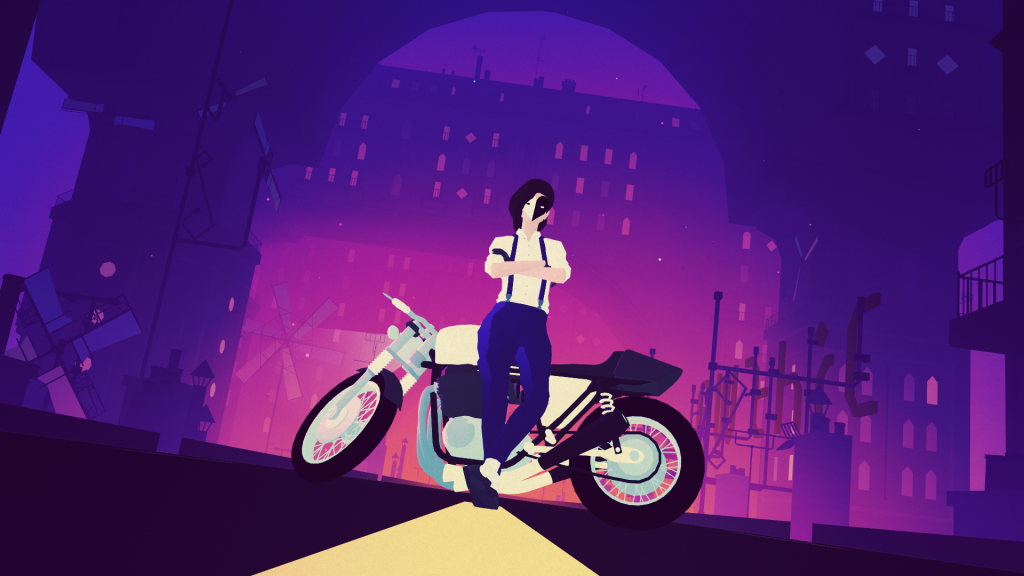In a blog post in 2016, Swedish developer Simogo talked about “Project Night Road,” which began production after launching the Wii U version of Year Walk. After working on several games for PC, Mac and iOS, the team wanted to do something bigger, faster and more direct. Several years later, we have Sayonara Wild Hearts, a rhythm action game that features a pop/electronic soundtrack, motorcycles, and dancing.
After its launch last month, its music and visuals continue to be stuck in my head. DualShockers recently got the chance to interview Simogo’s Simon Flesser and learn more about Sayonara Wild Hearts’ development, what inspired it, how Queen Latifah got involved, and so much more.
Early on, Simogo had ideas for the characters, their style, the inclusion of tarot cards, and motorcycles. Additionally, they knew they wanted the game to be constantly moving forward and on-rails. “Originally, I had envisioned something darker and more mysterious, and we even had little story bits in which you could control The Fool freely on-foot,” says Flesser. “As the idea about basing the game more around the music came, we realized we actually wanted to make an arcade-style game, so we ditched all of the bits that felt like it slowed the game down.”
With Sayonara Wild Hearts being a fast game, the developers wanted anyone to be able to play it, even if someone had never played a video game before. “We wanted to make the controls contextual and provide a minimum amount of inputs, while still providing something that felt as spectacular as a grand 3D game.” Another aspect of Sayonara Wild Hearts that interested me is the inclusion of tarot cards, and Flesser explained why they were included. “I wanted the game to be about fate and future,” continues Flesser. “Tarot cards have always been around me, since I was a child, so I’ve always wanted to include them in a project somehow.”
During the early stages of development where the game had a darker vibe, Simogo experimented with the music by including Ethipoian influences, surf rock, and taiko drums. As the game’s development went on, several song sketches and ideas fell through and didn’t make it into the final game. That being said, Annapurna Interactive will release “Faded Memories,” a cassette tape which features songs cut from the game.

Like any game in development, there were specific levels that were memorable or difficult to develop. “‘Begin Again’ was the first stage we made, so it took a really long time,” says Flesser. “You can sort of see that we use hard cuts in that level but in no later levels, as thinking about levels in several cuts proved to take a lot of time and planning.” Following “Begin Again,” they made “Mine,” but they scrapped the original version of the level they made. “You’d race into a castle and learn the ability to clone yourself so you’d control two versions of The Fool, while chasing The Lovers down castle hallways and up spiral stairs.” “Parallel Universes,” which was the last level they designed, only took a few days to make because they wanted to add one more level in before testing began.
During the testing phase of development, Flesser wished the game would have spoken narration in it. They said it would’ve been fun to have someone unexpected narrating the story bits. “I had been out for a beer or two, and was feeling somewhat jestful, and when Nathan asked me who I had in mind, I said ‘Queen Latifah!’ not being super serious, as I thought it’d be so far out of reach,” says Flesser. “Some weeks passed and suddenly Annapurna sent me a message saying that Queen Latifah would be able to record the next day.”

A week before its launch, it was announced that Sayonara Wild Hearts would make not only race its way to the Nintendo Switch and PlayStation 4, but also on Apple Arcade, Apple’s game subscription platform. “We were simply asked if we wanted to be a part of the service’s launch,” Flesser continues. “As Switch was already our main platform as we were developing it, the specs for the game was already quite low, so it was quite pleasant to bring it to mobile and keep the game running in native resolution and 60 frames per second.” The biggest challenge the developer faced was keeping it input-agnostic so that players could play it with any input devices. “Looking back, we should have built more robust design tools, which would have spared us a lot of headaches and time.”
With themes such as dealing with heartbreak, mental health, and starting over, Sayonara Wild Hearts is a game where almost anyone can relate to it. Its fast and frantic combat keeps players on their toes and offers a thrilling experience that no one should miss. It’s easily my game of the year and I can’t recommend it enough. When asked what they hope players take away from the game, Flesser said “I want the game to make people feel that they are awesome.”
The post Wild Hearts Never Die: An Interview with Sayonara Wild Hearts Developer Simogo by David Gill appeared first on DualShockers.
